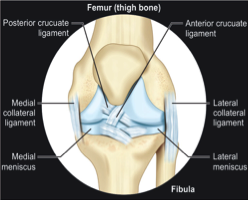Ligament and meniscus injuries of the knee:
Know your knee joint:

Four main ligaments in the knee are Anterior cruciate ligament (ACL),Posterior cruciate ligament( PCL), Medial collateral ligament(MCL) and Lateral collateral ligament (LCL). Apart from these ligaments there are two cushions like structures inside the knee joint which are called inner (medial ) and outer (lateral)meniscus. There are four bones around the knee joint: the thigh bone (femur), the main shin bone (tibia), the outer shin bone (fibula) and the knee cap (patella). Movements of the knee joint mainly take place between the femur and the tibia . Articular cartilage (a glistening smooth surface) lines the ends of the tibia and femur and the back of the patella around the knee joint. The articular cartilage is responsible for smooth movement between leg and thigh bones. In the old age, wear and tear of this cartilage is the main cause of knee pain related to old age.
Functions of ligaments and menisci in the knee joint: Ligaments stabilize the knee joint when we stand, walk or run. Menisci act like a shock absorber in the knee joint during walking and running.
How these structures get injured?
These ligaments can be injured in isolation or in combination. Knee ligament injuries are common sports injuries, although they may also occur during road traffic accidents. During sports a twisting impact on a bent or a straight knee is a common event and can injure the knee ligaments. Common mechanism of injury is landing on one leg and then quickly cutting or twisting the knee in the opposite direction.
An injury of knee ligament can span from a sprain in which a ligament is stretched out to a complete tear. A tear can be partial(only some of the fibers of the ligament are torn) or complete. These menisci can also be torn during sports injuries by twisting force. Fortunately, most of the knee injuries are sprains only and can be managed conservatively with early return to sports.
What are the signs and symptoms of a knee ligament injury?
In case of sprain there will be pain and tenderness on touching at the site of sprained ligament. If a ligament is completely torn a popping sound can be heard at the time of injury. This is followed by swelling due to bleeding into the knee, Knee movements are painful and there may be feeling of giving way or instability. If an injured knee is grossly swollen due to excessive bleeding into the knee joint doctor may drain the blood off the knee with a syringe and needle with aseptic precautions.
How is a knee ligament injury diagnosed?
Clinical examination of an injured knee by a sports injury specialist is often suffice to suggest the diagnosis. If clinician strongly suspects a ligament tear or a meniscal or cartilage injury he may refer you for an MRI to confirm the diagnosis. Remember acute stage is the best time to undergo an MRI.
What you should do after a suspected ligament injury to knee?
Always remember the initial treatment is "RICE"
- Rest : use knee brace and take a rest until the pain and swelling come down.
- Ice: apply ice every 2 hours for 10 minutes for the first two days. Ice is not effective if applied for less than 10 minutes. This will reduce pain and swelling will come down.
- Compression: apply compressive bandages around your knee. This will help limit swelling.
- Elevation: keep the limb elevated on a pillow while lying or up on a stool while sitting on a chair.
Do not harm – Don't apply any heat, don't run or massage.
Medication
Paracetamol is safe drug to be used for a few days after knee ligament injury. Don't use anti-inflammatory pain killers (NSAIDs) for more than 2-3 days as they may actually hamper the healing of torn ligaments.
Physiotherapy and exercises
Physiotherapy plays a key role in improving range of motion of the injured knee. It is also advised to maintain strength of the muscles which support the knee joint,before and after surgery.
Surgery
Sometimes surgery may be suggested after a knee ligament injury. This is more likely if you have complete ACL or LCL tear. Partial tear of the PCL and MCL often heal well with conservative treatment without surgery.
ABOUT THE AUTHOR

TESTIMONIAL

मेरा दाए पैर में चोट लगने के कारण टेढ़ा हो गया था जिसकी वजह से मुझे चलने में भी परेशानी हो रही थी. डॉ जितेश ने ऑपरेशन कर के इसे सीधा किया. में बिलकुल ठीक हूँ .

मेरी बेटी के घुटने में इन्फेक्शन होने के कारण वो दर्द की वजह से सो भी नहीं पाती थी. डॉ जितेश ने ऑपरेशन कर के इसे ठीक किया. बहुत धन्यवाद।

remember that Dr. Jain came out from his clinic to see my mother because my mother was not able walk a single step. He did total knee replacement on both side and now my mother is walking without aid.
OPENING HOURS
| Monday – Friday | 16:00 – 20:00 |
| Sunday | OFF |


